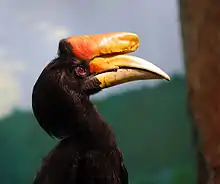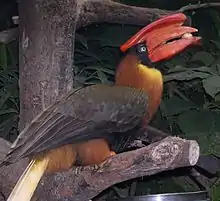| Buceros | |
|---|---|
 | |
| Rhinoceros hornbill Buceros rhinoceros | |
| Scientific classification | |
| Domain: | Eukaryota |
| Kingdom: | Animalia |
| Phylum: | Chordata |
| Class: | Aves |
| Order: | Bucerotiformes |
| Family: | Bucerotidae |
| Genus: | Buceros Linnaeus, 1758 |
| Type species | |
| Buceros rhinoceros (rhinoceros hornbill) Linnaeus, 1758 | |
| Species | |
|
See text. | |
| Synonyms | |
|
Hydrocorax Brisson, 1760 | |
Buceros is a genus of large Asian hornbills (family Bucerotidae).
Description
Hornbills in the genus Buceros include some of the largest arboreal hornbills in the world, with the largest being the great hornbill. All the hornbills in this genus have a large and hollow bony casque on their upper beak that can be useful to scientists and bird watchers to recognise their age, sex and species. Their wingspan can be up to 1.8 meters (6 foot) and they have the largest wingspan out of all the hornbills.
Taxonomy
The genus Buceros was introduced in 1758 by the Swedish naturalist Carl Linnaeus in the tenth edition of his Systema Naturae.[1] The name is from Latin becerus meaning "horned like an ox" which in turn is from the Ancient Greek boukerōs which combines bous meaning "ox" with kerōs meaning "horn".[2] The type species was designated as the rhinoceros hornbill (Buceros rhinoceros) by Daniel Giraud Elliot in 1882.[3][4]
Species
The genus contains three species:[5]
| Image | Scientific name | Common Name | Distribution |
|---|---|---|---|
 | Buceros rhinoceros | Rhinoceros hornbill | Borneo, Sumatra, Java, the Malay Peninsula, Singapore, and southern Thailand |
 | Buceros bicornis | Great hornbill | India, Bhutan, Nepal, Mainland Southeast Asia, Indonesian Island of Sumatra and North eastern region of India |
 | Buceros hydrocorax | Rufous hornbill | Philippines |
The helmeted hornbill is sometimes included in this genus, but today most authorities place it in the monotypic Rhinoplax instead.
References
- ↑ Linnaeus, Carl (1758). Systema Naturae per regna tria naturae, secundum classes, ordines, genera, species, cum characteribus, differentiis, synonymis, locis (in Latin). Vol. 1 (10th ed.). Holmiae (Stockholm): Laurentii Salvii. p. 104.
- ↑ Jobling, James A. (2010). The Helm Dictionary of Scientific Bird Names. London: Christopher Helm. p. 79. ISBN 978-1-4081-2501-4.
- ↑ Elliot, Daniel Giraud (1882). A Monograph of the Bucerotidae, or Family of the Hornbills. Published for the subscribers by the author. p. xvi.
- ↑ Peters, James Lee, ed. (1945). Check-List of Birds of the World. Vol. 5. Cambridge, Massachusetts: Harvard University Press. p. 270.
- ↑ Gill, Frank; Donsker, David; Rasmussen, Pamela, eds. (July 2021). "Mousebirds, Cuckoo Roller, trogons, hoopoes, hornbills". IOC World Bird List Version 11.2. International Ornithologists' Union. Retrieved 10 August 2021.
- Kemp, A. C. (2001). Family Bucerotidae (Hornbills). pp. 436–523 in: del Hoyo, J., Elliott, A., & Sargatal, J. eds. (2001). Handbook of the Birds of the World. Vol. 6. Mousebirds to Hornbills. Lynx Edicions, Barcelona. ISBN 84-87334-30-X